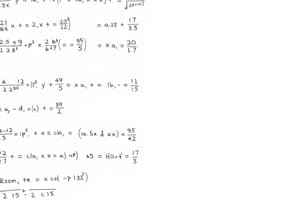Podcast
Questions and Answers
Match the following terms with their meanings:
Match the following terms with their meanings:
Directrix equation = Equation to find the location of the directrix in relation to the parabola's axis and focus Focal distance = Distance from the focus to the vertex of the parabola Directrix distance = Distance from the focus to the directrix Tangent line = Line perpendicular to the directrix at a point of contact on the parabola
Match the following properties with their descriptions:
Match the following properties with their descriptions:
Reflection = Forms the axis of reflection for parabolic mirrors Focus and Directrix Intersection = Point where distance from focus to directrix equals focal distance Tangent Line = Perpendicular to the directrix at any point of contact on the parabola Reflection Symmetry = Reflecting a point across directrix results in equidistant point on parabola
Match the following variables with their meanings:
Match the following variables with their meanings:
x = Horizontal position of the directrix k = Horizontal position of the focus p = Focal distance of the parabola d = Distance from focus to directrix (directrix distance)
Match the following statements with their correct definitions:
Match the following statements with their correct definitions:
Match the following features with their roles in defining a parabola:
Match the following features with their roles in defining a parabola:
Flashcards are hidden until you start studying
Study Notes
Parabolas and Their Directrix
A parabola is a familiar yet fascinating curve that's been captivating mathematicians and artists alike for centuries. As part of the family of conic sections, it's the result of slicing a cone with a plane at a specific angle. In this exploration, we'll delve into the concept of a parabola's directrix, a crucial element that defines its unique shape.
Parabola Basics
A parabola is a two-dimensional curve generated by a point moving in a plane while kept at a fixed distance from a fixed line called the axis of the parabola. This distance is twice the focal distance. The point on the axis that's closest to the moving point is the focus, and the line connecting the focus and the midpoint of the moving point's trajectory is the directrix.
Directrix Definition and Properties
The directrix is a line that lies perpendicular to the axis of the parabola. It's a key aspect of the parabola's shape because all points on the parabola are equidistant from the directrix and the focus. The directrix is the line that the moving point would hit if it continued to move away from the focus along its original path.
In the case of a parabola opening to the right, the directrix is a horizontal line. If the parabola opens to the left, the directrix is a horizontal line, but it's positioned to the left of the parabola's axis. Parabolas that open up or down have vertical directrixes.
Directrix Equation
The directrix equation is a way to find the location of the directrix in relation to the parabola's axis and the focus. The general directrix equation is:
[x = k - \frac{p}{d}]
In this equation, (x) represents the horizontal position of the directrix, (k) is the horizontal position of the focus, (p) is the focal distance, and (d) is the distance from the focus to the directrix, often called the directrix distance. The directrix's equation can also be rewritten in terms of the vertical position, (y), if the parabola opens up or down.
Useful Properties of Directrix
The directrix is a valuable tool for understanding the behavior of a parabola. Some useful properties include:
- Reflection: A line perpendicular to the directrix forms the axis of reflection for parabolic mirrors.
- Focus and Directrix Intersection: The focus of a parabola and its directrix intersect at the point where the distance from the focus to the directrix is equal to the focal distance.
- Tangent Line: The tangent line to the parabola at any point of contact is perpendicular to the directrix through that point of contact.
- Reflection Symmetry: Reflecting a point across a directrix results in a point on the parabola that's equidistant from the focus.
Parabolas and their directrixes are fascinating mathematical objects with numerous applications in physics, engineering, and design. The directrix is an essential component of a parabola, defining its shape and revealing many of its properties.
Studying That Suits You
Use AI to generate personalized quizzes and flashcards to suit your learning preferences.




